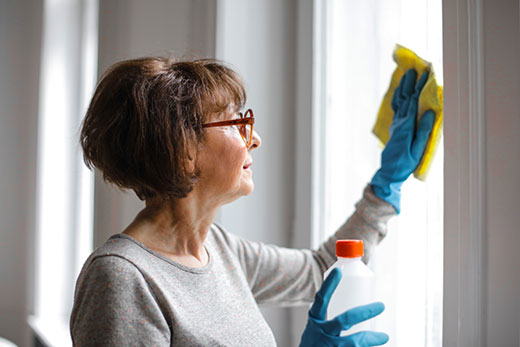
For safety, wear gloves and follow label directions when using household disinfectants.
Follow label directions closely when disinfecting surfaces, expert cautions
Unsafe mixtures have caused spike in accidental home poisonings
April 29, 2020
MANHATTAN, Kan. – The leader of a Kansas State University program that helps to promote food and consumer safety at home is waving a caution flag regarding the proper ways to disinfect kitchen and other household surfaces.
Karen Blakeslee, coordinator of the K-State Rapid Response Center, said her concern stems from an April 24 article from the U.S. Centers for Disease Control and Prevention indicating that the number of incidents received by the nation’s poison control centers between January and March, 2020, climbed a whopping 20.4% over the same period one year ago.
The CDC data indicate there were 45,550 exposure calls relating to cleaners and disinfectants received during the first three months of this year, compared to 37,822 in 2019. In the article, the CDC cites two examples in which exposure to poisonous chemicals resulted from homeowners taking extra steps to protect food or surfaces from potential exposure to the novel coronavirus.
In one case, a woman filled a sink with a mixture of 10% bleach solution, vinegar and hot water and soaked produce that she had purchased at the grocery store. She was transferred to the hospital after experiencing breathing difficulties caused by the chemical mixture.
“The message here is that we need to use cleaners and disinfectants as directed and for the type of surface you are cleaning,” Blakeslee said. “And it’s important to note that you do not need to sanitize groceries after bringing them home from the grocery store. What the U.S. Food and Drug Administration recommends is that you wash your hands when returning from the store, put your groceries away safely, then wash your hands again.
“There is no indication that the novel coronavirus can be carried and transmitted to humans from food or food packaging.”
Blakeslee notes that the CDC’s recommendations for cleaning and disinfecting home surfaces are fairly simple: wear disposable gloves to clean and disinfect, and use soap and water to clean surfaces.
“You should clean surfaces regularly, especially high touch surfaces” including tables, doorknobs, light switches, countertops, handles, desks, phones, keyboards, toilets, faucets and sinks, Blakeslee said.
To disinfect areas of the home, the surface should first be cleaned with a simple solution of soap and water, or a mild detergent if the surface is dirty. Then, Blakeslee notes, use a household disinfectant.
The U.S. Environmental Protection Agency maintains a list of recommended disinfectants for home use to help protect against the coronavirus and other viruses. Consumers are reminded to follow label directions and be sure to follow the contact time, which is the amount of time that a surface should be visibly wet.
Blakeslee said the CDC also has recommendations for using bleach solutions, when appropriate for the surface being disinfected. The CDC’s recommendation for a safe bleach solution is listed as 5 tablespoons (1/3 cup) bleach per gallon of water; or 4 teaspoons bleach per quart of water.
Alcohol solutions with at least 70% alcohol may also be used, according to the CDC.
When reviewing disinfectants for the home, “do not mix any of these cleaners together thinking it will be a better cleaner,” Blakeslee said. “That is dangerous.”
“There is the added factor right now that children are home, which increases the possibility of poisoning,” she adds. “Keep all cleaning and disinfectant products out of reach of kids, or locked in a cabinet.”
Blakeslee said that if a poisoning does occur in the home, seek immediate medical attention, or call Poison Control at 1-800-222-1222.
More food safety information related to COVID-19 is available online from K-State Research and Extension.

